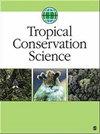墨西哥中部温带森林中宗教冷杉(Abies religiosa)残余种群的精细空间遗传结构
IF 1.6
4区 环境科学与生态学
Q2 BIODIVERSITY CONSERVATION
引用次数: 0
摘要
种群的遗传结构可以由景观的阻力或种群之间的距离塑造,这是基因流动的障碍。在精细空间尺度上分析了宗教冷杉(Abies religiosa)的群体遗传结构,并通过抗性和距离考察了其隔离模式。在墨西哥中部拉马林奇国家公园(LMNP)的南、北、东三个斜坡上,采集了该物种分布高度极值的种群的营养组织。采用CTAB 2X法获得基因组DNA,扩增出8个微卫星叶绿体位点。利用分子方差分析、交叉验证的主成分判别分析和gabriel型连接网络的空间主成分分析对其遗传结构进行了鉴定。利用互因模型和最大似然群体效应模型构建部分Mantel检验,对隔离假设进行评估。鉴定出了一种抗海拔隔离的遗传结构,并确定了两个遗传群:一个包括南坡种群,另一个包括北坡和东坡种群。我们在LMNP的冷杉种群中发现了一种由海拔抵抗决定遗传结构的隔离,并且在高海拔种群群体之间的遗传交换最大。建议通过辅助迁移促进斜坡间的连通性,并立即停止土地利用变化,作为保护LMPN遗传多样性的行动的一部分。本研究有助于了解墨西哥温带森林濒危物种的空间遗传结构,为其保护提供依据。本文章由计算机程序翻译,如有差异,请以英文原文为准。
Fine-Scale Spatial Genetic Structure of Remnant Populations of Abies religiosa, in a Temperate Forest in Central Mexico
Genetic structure of a population can be molded by the resistance of the landscape or the distance between populations that function as barriers to gene flow. We analyzed the population genetic structure of Abies religiosa on a fine spatial scale and examined isolation models by resistance and distance. We collected vegetative tissue from populations located at the altitudinal extremes of the distribution range of the species on three slopes of La Malinche National Park (LMNP) (South, North, and East) in central Mexico. Genomic DNA was obtained using the CTAB 2X method, and eight microsatellite chloroplast loci were amplified. The genetic structure was identified based on an Analysis of Molecular Variance, a Discriminant Analysis of Principal Components with cross-validation and a spatial Principal Component Analysis using the Gabriel-type connectivity network. The isolation hypotheses were evaluated by constructing partial Mantel tests using Reciprocal Causal Modeling and Maximum Likelihood Population Effects models. A genetic structure of isolation by resistance to elevation was identified, and two genetic groups were recognized: one including populations of the South slope and the other comprising populations of the North and East slopes. We detected in Abies religiosa populations of the LMNP an isolation by resistance to elevation that determines the genetic structure, and the greatest genetic exchange between groups of populations located at higher altitudes. It is suggested to promote the connectivity between slopes through assisted migration and immediately halt land-use changes, as part of the actions to preserve genetic diversity in the LMPN. This study contributes to the knowledge of the spatial genetic structure of species at risk in the Mexican temperate forest for their conservation.
求助全文
通过发布文献求助,成功后即可免费获取论文全文。
去求助
来源期刊

Tropical Conservation Science
BIODIVERSITY CONSERVATION-
CiteScore
3.60
自引率
5.90%
发文量
16
审稿时长
>12 weeks
期刊介绍:
Tropical Conservation Science is a peer-reviewed, open access journal that publishes original research papers and state-of-the-art reviews of broad interest to the field of conservation of tropical forests and of other tropical ecosystems.
 求助内容:
求助内容: 应助结果提醒方式:
应助结果提醒方式:


